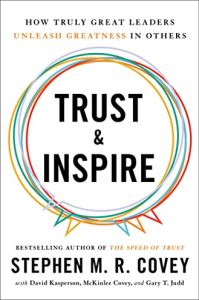Join getAbstract to access the summary!

Join getAbstract to access the summary!
Stephen M.R. Covey
Trust & Inspire
How Truly Great Leaders Unleash Greatness in Others
Simon & Schuster, 2022
What's inside?
Replace command and control with “Trust & Inspire” – a leadership philosophy with purpose.
Recommendation
Stephen M.R. Covey offers an alternative to command-and-control leadership: Trust & Inspire. Covey explains how this approach aligns with modern sensitivities and fulfills the pressing need for effective corporate management. He teaches leaders to become stewards of their workforce by offering a model of morality and virtue to build trust and provide inspiration. Covey calls on leaders to demonstrate imperative workplace virtues – humility, courage, authenticity, vulnerability and empathy – to create and maintain an abiding sense of mission, purpose and endurance.
Take-Aways
- Traditional command-and-control leadership treats people like fleas in a jar.
- “Trust & Inspire” leadership respects and empowers people.
- Trusted, inspirational leaders are responsible stewards.
- Model your behavior on the actions of leaders you admire.
- The best leaders embody the values they want others to display.
- Trust-and-inspire leaders hold different beliefs than command-and-control leaders.
- These leaders are bold and brave.
- Teams need trustworthy, inspirational leadership.
Summary
Traditional command-and-control leadership treats people like fleas in a jar.
If you put fleas in a glass jar, they quickly jump out. Put more fleas in the same jar, screw a lid on and the fleas will smash themselves against the inside of the lid trying to gain freedom.
Can you guess what happens when you remove the lid? Although the fleas now could jump out easily, they won’t even try. They don’t want to hurt themselves banging up against a possible obstruction. You have conditioned them against jumping out of the jar and have severely circumscribed their potential.
“If all else fails, [command and control]…is about barking out the orders, so everyone does exactly what they’re supposed to do – not because they want to, but because they have to.”
Archaic command-and-control management resembles this harsh conditioning and limits the capacity of its people. The time has come to retire this approach and replace it with a system that earns people’s trust and inspires them.
Wise executives and managers now embrace a new leadership method and mind-set: “Trust & Inspire.”
Trust-and-inspire leadership respects and empowers people.
Trust and inspire is a fresh way to exercise leadership. It maximizes everyone’s possibilities for growth, makes the most of people’s talents and empowers them to consistently give their best performance. Trust-and-inspire leadership gives people a sense of purpose. It shows that you care about your employees, and it connects them with you and their colleagues in a meaningful way.
“When you are inspired by some great purpose, some extraordinary project, all your thoughts break their bounds. Your mind transcends limitations, your consciousness expands in every direction, and you find yourself in a new, great and wonderful world.” (The Yoga Sutras of Patanjali)
Being a good leader calls for caring about the people you lead and demonstrating that concern daily in all your actions and in all aspects of your organization.
Trusted, inspirational leaders are responsible stewards.
To be a trustworthy, inspiring leader, view leadership as stewardship.
“A good leader inspires people to have confidence in the leader; a great leader inspires people to have confidence in themselves.” (Eleanor Roosevelt)
People trust stewards to handle crucial responsibilities and tasks. Stewardship can take three forms:
- Modeling – Stewards consistently model their “credibility and moral authority” and “behavioral virtues” as a leader. As the great humanitarian Albert Schweitzer said, “Example is not the main thing in influencing others; it’s the only thing.” The people you lead will model their behavior on your behavior, good or bad.
- Trusting – Leading with trust means having confidence in the people around you and helping them grow. When you show the people you lead that you trust them, they will reciprocate. Your faith in your employees will encourage them to rise to the challenges of their work to demonstrate that they merit your trust.
- Inspiring – Stewards connect with the individuals they lead, but they also feel connected to an elevated, inspirational purpose. In today’s chaotic world, inspirational leadership is quickly becoming a “strategic imperative.”
Model your behavior on the actions of leaders you admire.
To become a trusted, inspiring leader, find a role model you admire and emulate his or her actions and behaviors.
And as you do, study the classic Greek philosophers’ focus on three leadership standards: “ethos, pathos and logos.” Ethos concerns your personal credibility. Show your people that they can always trust you; that you’ll do what you say you will do. Ensure your public and private statements and actions align. Pathos encompasses your emotions and how you relate to other people. Make sure your emotions are in sync with the way those around you feel, and that you support their emotional needs. Logos concerns logic. Take care to act in a logical, rational way that is appropriate in scale to the cirumstances.
“Treat people as they are, and they will remain as they are. Treat people as they can and should be, and they will become as they can and should be.” (Goethe)
As you emulate the trust-and-inspire leaders you admire, adopt these leadership traits:
- Listen intently.
- Admit when you’re wrong, have made mistakes, are unsure of a pending decision or need to study a matter further.
- Be loyal, humble and courageous; keep your promises and tell the truth.
- Hold yourself accountable for your words and deeds.
- Take responsibility for any substandard results and work to correct them.
- Operate with full transparency and no hidden agendas.
- Respect others and give them the benefit of the doubt.
The best leaders embody the values they want others to display.
To inspire those you lead, model certain “behavioral virtues.” Trust-and-inspire leadership views these virtues as pairs of behaviors that influence, balance and support one another:
- Humility and courage – Many humble people lack courage, and many courageous people lack humility. Humility is an essential bedrock virtue. Most humble people understand that their core principles govern everything they do. Courageous people aren’t afraid to do what’s right, even if it undermines their popularity, status or financial well-being. Work to be both humble and courageous.
- Authenticity and vulnerability – In the age of social media, when every person online has an opinion and a giant megaphone, separating fact from fiction and good ideas from nonsense grows increasingly difficult. In today’s social media onslaught of Instagram influencers and fake news, you may have difficulty differentiating the authentic from the fraudulent. Trusted leaders are honest and authentic. They aren’t afraid to show vulnerability by being open to others and demonstrating their emotions, fears, insecurities and strengths. Vulnerability provides the gateway to authenticity.
- Empathy and performance – These two traits function independently of each other and yet prove crucially interdependent. When leaders show empathy for their team members, they become inspired to do their finest work. When you moderate disputes between your teams, listen with care to both sides. Show your empathy for both positions; this builds trust, which fuels performance.
Trust-and-inspire leaders hold different beliefs than command-and-control leaders.
Leaders who want to be trustworthy and inspiring think and behave differently than restrictive command and control leaders. They believe in their people’s potential and capacity.
These leaders live according to five primary beliefs. First, they believe their people have the capacity to be great. They help the people they lead live up to their highest possibilities. They look for greatness in everyone, even those whose potential is hard to discern at first.
Nature offers an example of dormant potential: California’s Death Valley is the hottest place in America. Rainfall usually totals only one to two inches annually, but Death Valley experienced an amazing six inches of rain in the winter of 2004. The following spring, wildflowers carpeted Death Valley. So even Death Valley isn’t really dead; it’s dormant, yet filled with life-affirming potential. This is exactly how trust-and-inspire leaders view the people they lead.
“The difference between what we are doing and what we’re capable of doing would solve most of the world’s problems. (Mahatma Gandhi)
Second, these leaders see their employees as entire beings. People have many layers, and wise leaders treat them as multifaceted. Command-and-control leaders often address only their followers’ physical needs, and ignore their emotional and mental needs. Consider your employees’ “body, heart, mind and spirit.”
Third, focus on caring, not competing. Trust-and-inspire leaders believe in sharing credit, responsibility and rewards. To illustrate, the author grew up in a family with many children, so sometimes they'd quarrel over extra helpings of their favorite foods. This is the dog-eat-dog world of command and control, a zero-sum game in which whatever one person gets means less for another.
The command-and-control world breeds five emotional pitfalls: “competing, contending, complaining, comparing and criticizing.” But these ills have no place in the world of leaders who possess an “abundance mentality.” They understand and demonstrate there is plenty to go around for everybody.
The fourth primary belief of trusted, inspirational leaders is that leading is stewardship. These leaders devote themselves to service, not self-interest. They work to improve themselves, their colleagues, their employees, their organizations, their communities and their world.
The fifth core belief is that leaders should work to have a lasting impact “from the inside out.” They make sure the positive influence they create with their stewardship doesn’t dissipate if they aren’t around. To accomplish this, they inspire their people to be bold and self-motivated – to find within themselves the strength to do their best, even if their external role model isn’t at hand.
These leaders are bold and brave.
Trust-and-inspire leaders are always the first ones through the door. Consider, for example, television host Fred Rogers, who took a courageous stand on his beloved children’s television show, Mister Rogers’ Neighborhood. The laws in the United States in the late 1960s were intended to prevent racial segregation, but segregation remained rampant in many ways – but Fred Rogers was a pioneer. His show introduced the first Black character to re-appear regularly on children’s television, Officer Clemmons.
“Example is not the main thing in influencing others; it’s the only thing.” (Albert Schweitzer)
In one episode, Rogers invited Clemmons to join him in soaking their bare feet in a wading pool. In the late 1960s, this was a significant symbolic act – at the time, most public swimming pools in the United States remained segregated.
Due to his bravery and willingness to take the lead, Fred Rogers had a positive influence on the state of racial integration in the United States.
Teams need trustworthy, inspirational leadership.
In 2001, Erik Weihenmayer and a large climbing team made it to the summit of Mount Everest. Weihenmayer was the first blind mountain climber to accomplish this incredible feat. Fewer than one-third of the climbers who attempt to summit Mount Everest succeed, but Weihenmayer made it.
He and expedition leader Pasquale Scaturro developed a plan that would enable the blind climber, with the help and encouragement of Scaturro’s team, to scale the world’s tallest mountain. Weihenmayer was an accomplished climber, and had the hard-won skills, spirit and heart for this heroic venture.
“What’s within you is stronger than what’s in your way…I think everybody has a yearning for greatness.” (Erik Weihenmayer)
Weihenmayer added his name to the list of those who have conquered Everest thanks to the positive outlook of Scaturro’s team members and the close friendships they shared.
Every night during the climb, Scaturro organized a “tent meeting” in which the team members discussed the various problems they’d encountered during that day’s climb and planned ways to avoid similar difficulties during the next day’s ascent.
These meetings were not only practical; they also brought Scaturro, Weihenmayer and the other team members closer. This enhanced team spirit became essential when Scaturro fell sick with malaria, had to leave the climb and work his own way back down the forbidding mountain.
A couple of days later, a perilous storm descended onto Mount Everest. Despite the increasing challenges, the team members, now leaderless, decided to continue their climb. Weihenmayer and the remaining 18 members of the team achieved their goal and arrived at the top of Mount Everest.
The team’s mutual goal was not merely to reach the summit, but to help their blind companion do so as well. Working on his behalf enabled the team members to set aside individual fears or goals and work together, trusting and inspiring each other.
About the Author
CEO of CoveyLink Worldwide Stephen M.R. Covey is also the author of the New York Times bestseller The Speed of Trust. He is the son of the late Stephen R. Covey, author of The 7 Habits of Highly Effective People.
This document is restricted to personal use only.



























Comment on this summary